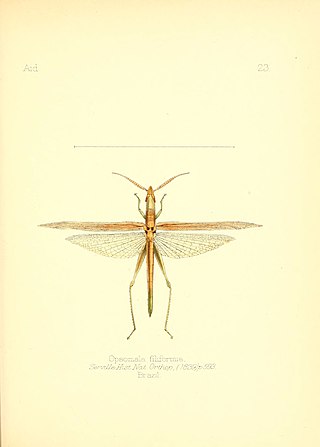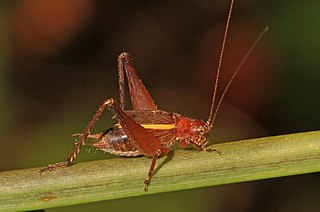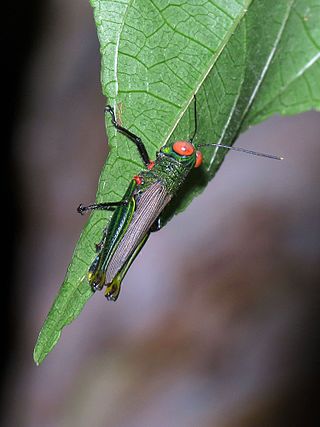
Ensifera is a suborder of insects that includes the various types of crickets and their allies including: true crickets, camel crickets, bush crickets or katydids, grigs, weta and Cooloola monsters. This and the suborder Caelifera make up the order Orthoptera. Ensifera is believed to be a more ancient group than Caelifera, with its origins in the Carboniferous period, the split having occurred at the end of the Permian period. Unlike the Caelifera, the Ensifera contain numerous members that are partially carnivorous, feeding on other insects, as well as plants.

Trigonidiinae is a subfamily of insects in the order Orthoptera, suborder Ensifera, based on the type genus Trigonidium. They are often referred to as sword-tail crickets, winged bush crickets or trigs.

The Eneopterinae are a subfamily of crickets, in the family Gryllidae, based on the type genus Eneoptera. It is one of several groups widely described as "true crickets". Of the more than 500 species that make up this subfamily, most occur in moist, tropical habitats. These insects are medium to large and brown or gray in color. They eat plant leaves, flowers, and fruits and can occasionally cause economic damage. Their eggs are deposited in pith, bark, or wood. Eneopterinae show a great diversity in stridulatory apparatus, signals emitted, and associated behaviour.

Syrbula montezuma, known generally as the Montezuma's grasshopper or slant-faced grasshopper, is a species of slant-faced grasshopper in the family Acrididae. It is found in Central America and North America.

Tettigoniidea is an infraorder of the order Orthoptera, with six extant families.

Trimerotropini is a tribe of band-winged grasshoppers in the family Acrididae. There are at least 70 described species in Trimerotropini: found in the western Americas.

Cyrtoxipha is a genus of green trigs in the family Gryllidae. There are at least 30 described species in Cyrtoxipha.

Syrbula is a genus of slant-faced grasshoppers in the family Acrididae. There are at least three described species in Syrbula.

Heliastus is a genus of band-winged grasshoppers in the family Acrididae. There are about 10 described species in the genus Heliastus.

Phyllopalpus is a genus of winged bush crickets, trigs in the family Trigonidiidae. There are about six described species in Phyllopalpus.

Leptysminae is a subfamily of spur-throat toothpick grasshoppers in the family Acrididae. There are at least 20 genera in Leptysminae, found in North, Central, and South America.

Pentacentrinae is a subfamily of crickets in the family Gryllidae. Sometimes known as 'Silent Litter Crickets', they occur in tropical Asia, Africa and the Americas. The tribe Lissotrachelini Hubbell, 1938 has been moved to the Nemobiinae.

Podoscirtinae is a subfamily of crickets in the family Gryllidae.

The Gryllotalpoidea are a superfamily of insects that includes the mole crickets and the ant crickets. The type genus is Gryllotalpa.

Hapithini is a tribe of crickets in the subfamily Hapithinae. There are about 12 genera and more than 260 described species: found in Central and South America.

Episactidae is a family of grasshoppers in the order Orthoptera. There are about 19 genera and more than 60 described species in Episactidae, found in Central and South America, China, and Madagascar.
Mastacideidae is a family of grasshoppers in the order Orthoptera. There are at least two genera and about eight described species in Mastacideidae, found in South Asia.
Xyronotidae is a family of Central American grasshoppers in the order Orthoptera. There are at least two genera and four described species in Xyronotidae.

Proctolabinae is a subfamily of grasshoppers in the family Acrididae. There are more than 20 genera and 210 described species which are found in South America.
Pterophyllini is a tribe of true katydids in the family Tettigoniidae. There are about 16 genera and more than 40 described species in Pterophyllini.

















